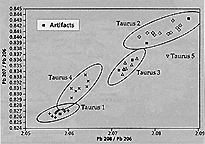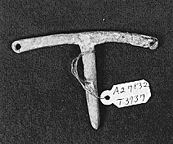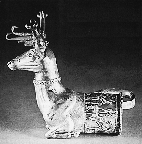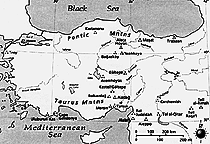A Metalliferous View from the Central Taurus
By K. Aslihan Yener, Assistant Professor, The Oriental Institute
and the Department of Near Eastern Languages and Civilizations
The University of Chicago
(This article originally appeared in Biblical Archaeologist 58:2 (1995), and is made available electronically with the permission of the editor. This electronic version corrects two erroneous site references on page 103 as well as correcting site labelling errors with the map of Turkey in the print version.)
Bibliography
Dedicated to Peter Neve
PETER NEVE is to be congratulated for contributing vastly to the archaeological knowledge of the Hittite empire. This article in his honor collects observations on the nature of metal industries in Anatolia, with special reference to the Hittites. Along with this, I make some suggestions for sourcing the ores which were exploited from the Chalcolithic period to the Late Bronze Age in the south-central Taurus mountains. This provides some insights into the resource strategies of the Hittite and earlier cultures by illuminating a highland industry which is often missing in the archaeological record.
One of the more puzzling aspects of Hittite imperial geography has been the location of the Hittite capital, Bogazköy ( Hattusa), in north central Turkey. A large number of the excavated documents reflect imperial political and economic interests in bellicose southern regions, such as Carchemish, Aleppo, and Alalakh. Yet the Hittites chose to manage their empire from the mountainous region in the north---an area which was sometimes politically troublesome. Powerful military forays descended into the southern Syro-Anatolian bread basket, a place which had fluctuating allegiances with Egypt. This arena of great conflict between Egypt and Hatti had yet another important asset: rich mineral resources and metallurgical technology. Recent archaeometallurgical studies in the Taurus and Amanus ranges make this wealth evident. The same holds true for north central Turkey which has mineral resources that are easily accessible in the Pontic Mountains. As a result, exceedingly complex relationships emerge between the Hittite imperial center and its resource-rich frontiers.
Of particular interest is the nature and impact of metal manufacture on the producers of metals when urban demands from imperial centers such as Hattusa increased. The attempt to control access to needed highland resources was the strategic rationale for a number of third and second millennium legends involving the military intervention of various lowland armies. The magnitude of that intrusion has been largely unknown since the archaeological history of the highland industrialists has been understood only recently.
Excavations at Hattusa, the capital of the Hittite empire, revealed a people with considerable engineering skills and distinct organizational strategies. The Hittites were able to integrate the mountainous terrain of their empire with their building technologies. They were heirs to a metal technology which had unparalleled development in Anatolia since the eighth millennium BCE (Maddin 1988). The Sungurlu area in north central Turkey around the highland capital, Bogazköy, is fertile in agricultural potential, and even more significantly, it has an environment rich in metals, minerals, and wood. These resources clbound in the Pontic Mountains to the north and the Taurus range to the south. Thus, Hittite industries had some strategic advantages over the lowland empires by their immediate access to metalliferous deposits, forest supplies, and abundant game. Clearly a large number of areas to the south such as Kizzuwatna, elusive Tarhuntassa, and the "Silver Mountain" Taurus and Amanus ranges were quickly integrated into the empire. This suggests that resource procurement was important. By commanding priority rights over these resources, the Hittites had an economic risk strategy that provided insurance in times of imperial financial difficulties.
Finally, it is worth reiterating the obvious point that exchange networks tapping into the resource areas were established in the periods prior to Hittite ascendancy (Marfoe 1987). These exchange networks were at least maintained and possibly strengthened during the Hittite period. This paper deals with only a small portion of the Hittite metal industry, sketching the implications of source characterization by lead isotope analysis published earlier (e.g., Yener et al. 1991). Over the last decade this analysis has provided some insight into the nature of metal exploitation patterns.
Some Aspects of Hittite Metallurgy
It has long been acknowledged that the highland regions of Anatolia, rich in natural resources, were among the earliest places where metallurgy developed. In this region, metallurgy advanced in the Near East and from here metallurgical technologies spread to neighboring Mesopotamia and Syria. Styles and traditions of metalworking exhibit great inventiveness here. The products of these techniques---the metal objects themselves---display a virtuosity that often outshines other aspects of technology as a whole. The most striking feature of this metallurgical tradition is its precociousness. From the earliest occurrences of metal objects in the aceramic Neolithic (eighth millennium BCE) through the discovery of iron metallurgy, this innovative characteristic never altered. It encompassed the very early recognition of the ductility of copper as well as the late fourth millenium BCE discovery of the strength, range, and colors of functional alloys. This knowledge was put to use in both decorative and utilitarian objects.
Current understanding of Hittite metallurgy comes from metal assemblages excavated from several Late Bronze Age sites such as Bogazköy, Masat, and Alaca Höyük. A partial list of these assemblages includes metal armor, weapons, pins, tool, wagons, figurine, seals, and treaties. Several examples of bull and deershaped rhytons of silver, such as the stag vessel with frieze (Muscarella 1974), and the fist-shaped vessel in Boston's Museum of Fine Arts (Güterbock and Kendall 1995) reflect the developed nature of their craft (Güterbock 1983). A recent hoard found near Kastamonu produced other examples of ritual iconography in metal: plates engraved with hieroglyphic inscriptions and decorated with registers in relief of griffins; trees of life, combat scenes with lions and bulls; lions and lions; and hunting scenes (Emre and Cinaroglu 1993). Moreover a fragment of an oxhide ingot of copper excavated at Bogazköy (Müller-Karpe 1980) links this seemingly landlocked empire with a circum-Mediterranean maritime commerce. This network moved tons of copper and tin during the Late Bronze Age and was revealed in the spectacular results of the underwater excavations at Uluburun Kas and Cape Gelidonya (Bass et al. 1989; Maddin 1989).
The quantities of metal objects with ritual significance began early, as the findings at Troy and Alaca Höyük demonstrate. Weapons are prominent members of this grouping. Two examples from the Middle Bronze Age are a bronze spearhead engraved with inscriptions of Anitta the King and a sword dedicated to the god Nergal (Güterbock 1964). Engraving inscriptions onto metal continued into the Hittite period. A sword with an Akkadian inscription celebrates Tuthaliya II's victory over the western Assuwa-land (1430 BCE). The inscription dedicated the sword to the storm god (Ertekin and Ediz 1993, Ünal 1993). Another example of a numinous weapon is a spearhead inscribed walwaziti ,"Greatscribe," probably dating to the reign of Hattusili III and Queen Puduhepa (Bilgi and Dincol 1989). Swords and axes were decorated with human, animals, and fantastic divine creatures. These weapons have a smooth background from which figures stand out in relief Their forms are reflected in the Hittite relief depicting the Dagger God at Yazilikaya, which may have been based on a metal prototype. Its hilt is shaped like a god's head framed by four lions (Bittel et al. 1941). In addition to weapons, treaties were cast in metal. Recent excavations at Bogazköy revealed a bronze tablet inscribed with a treaty between Tuthaliya IV and Kurunta, King of Tarhuntassa (Otten 1988; Houwink ten Cate 1992).
Aside from the expected metal tools, weapons, and jewelry, the variety of metal artifacts manifest the tremendous extent to which metal was used in shaping objects (Boehmer 1972,1979; Waldbaum 1978). A whole range of shaping techniques (Maxwell-Hyslop 1971) exists in the artifacts of non-ferrous fabrication: chasing, cloisonné, filigree, granulation, drawing of wire, and various methods of gilding and repoussé. Tools, weapons, ornaments, figurines, and toilet articles were cast and hammered. Sheet metal was crafted and a number of fittings were cast and riveted (for techniques see Moorey 1985; Moorey and Fleming 1979,1984).
Texts by the hundreds exacavated at Bogazköy refer often to objects made of metal. A number of the texts mention ceremonial artifacts that are multi-media and polychrome: decorated with tin, gold, silver, rock crystal, ivory, alabaster, and lapis lazuli (Güterbock 1983). A valuable dagger is described as "its front shimmering, its tail and pommel of rock crystal" (Kosak 1982) while another text speaks of a votive gold bow (Güterbock 1989). Writing boards are described as equipped with writing implements of gold. There are iron ritual objects such as the animal attributes of the major deities, specifically lions and bulls, as well as animal shaped rhytons and human statues cast of iron or made of wood and inlaid with gold, silver, and tin. Inventory texts enumerate metal chariot, axes, horse bit, arrows, sickles, and maces. Other utilitarian objects such as weapons and tools are described as being made of iron (Kosak 1985; Muhly et al. 1985). Textual references conjure up a whole arsenal of metal weapons.
Inventory lists of luxury items witness to the extent of moveable and storable wealth in the Hittite empire. These include silver pyxis, gold and silver necklaces, pins, copper bathtubs, cymbals, and other musical instruments. Garments were lavishly decorated with gold and silver appliqués, gold pendants, and beads. An iron throne was given to the earlier Middle Bronze Age monarch, Anitta the King of Kanesh, while iron blooms, lumps, and iron smelting (?) hearths are mentioned in Hittite texts. A tub, small figurines, and ornamental jewelry are also mentioned as being made of iron. Texts made the distinction between meteoric iron (referred to as black iron of heaven) and terrestrial (smelted) iron; copper and iron can be qualified by "good" or "not good."
The provenance of various metals is sometimes listed. Most relevant to this discussion is the state of Kizzuwatna (Cilicia) which supplied the Hittite center with silver, copper, and tin. The amounts of metal from tribute lists are noteworthy as well: 42 minas; 16 minas 30 shekels; 134 minas. From another text, 56 iron blades for daggers, 8 blades for use in the kitchen, 16 maces of black iron, two thousand blades, and over 2,200 other metal objects are listed as tribute. At times copper is listed as ingots from 2 to 40 minas. Weights in larger scale, talents, are also mentioned. Silver ingots averaged about 1.5 to 2 minas.
Production in the Industrial Highlands
A dramatic economic threshold was crossed in the variety, quality, and quantity of metals manufactured. Metal was a critical high technology in a number of ways. It was the standard of value, medium of exchange, and the raw material of tool and weapon industries. Often metal was a vehicle for complex reciprocal gift exchanges. Yet reconstruction of these processes and economies often neglects the technologically advanced mining and smelting operations that were the backbone of the industry. The dynamics of provisioning metal to lowland centers and the impact of this industry upon different subsystems of Anatolian society are much more complex than the Hittite artifacts found in excavations lead us to believe. Thus, while the metal objects from Late Bronze Age sites highlight sophisticated metallurgical skills, their very existence at this level points to a hidden production technology which operated at industrial strength in the mountain source areas.

What emerges from behind the inventory lists and excavated metal artifacts is the existence of a many tiered, complex production industry. The first tier was the extraction and smelting sites in the mountains. The manufacture of metal at the mines and smelting sites (de Jesus 1980) is the least-studied major aspect of early states. Information from specialized function sites in the resource zones has been comparatively scarce, leading to an understanding of metallurgical techniques skewed toward the end users. Yet the primary industrial phase took place in the mountain zones and consisted of extraction, mining, smelting, and refining. It is this industry that is mostly missing in the archaeological record for the Hittite, though such industrial operations were already in operation in the Early Bronze Age as evidenced by the metal processing site, Göltepe, and the tin mine, Kestel (Yener and Vandiver 1993).
Workshop production centers found at urban lowland sites constitute the second tier of the metal industry. The technological aspects of the urban workshops can be gleaned from the artifacts, as well as from the specialized craft assemblages unearthed at Bogazköy (Neve 1992, Bachmann 1984) and the Assyrian Colony period at Kültepe (Özgüc 1955,1986). Urban workshops executed alloying, casting, inlaying, shaping, and other refinements. Hittite ritual texts and functionally important objects make clear the strategic and economic ramifications of this multi-faceted industry. Arsenical copper is the majority alloy represented. Nickel, tin, and lead alloys are present in late Hittite artifacts (Bachmann 1984). The diversity of metals and the technologies of their production presuppose some form of relationship with special function industrial sites in the mountains. Whether the Hittites engaged in reciprocal exchange with the polities controlling the mines or whether they directly controlled the production by politically integrating the source areas, hardly alters the impressiveness of the still mute industrial system as a whole.
The South-Central Taurus Metal Sources
The identification of exotic materials and products is one of the functions to which archaeology is best suited. Trade between the metal-rich highlands and urban centers held significance as a social force, if only as the link between mining production and consumption of metal commodities. Highland metalliferous zones supplied pre-state societies in Anatolia from the Chalcolithic period or earlier. This dynamic continued for the later Hittite imperial periods as well. Recent anthropological research demonstrates that demands for metal and its trade increased with the emergence of a hierarchy in administration (Rowlands, Larsen, and Kristiansen 1987). This traffic in metals may partly be definable by the use of lead isotope analysis.


The use of isotope ratios of lead to characterize sources and objects depends upon the fact that the lead ores occurring in different mining regions differ from one another in their isotopic compositions. These can then be used as "fingerprints" with which to compare isotopic ratios derived from artifact samples (Gale et al. 1985). Isotopic ratios can also be derived for ores containing other metals besides lead; many ore bodies are polymetallic and, therefore, are potentially capable of being analyzed using this technique. The methodology and data handling aspects of the research have been published elsewhere (Yener et al. 1991; Sayre et al. 1992). The implications are given below. Since the selection and processing of ores are directly reflected in the lead isotope ratios, this analysis will help assess the possibility that various Anatolian sources were exploited in the formative years of metallurgy and that some form of local and nonlocal exchange has taken place.
The central Taurus range in Turkey has been well defined isotopically. A number of Syrian and Anatolian artifacts have isotopic ratios that suggest that they were derived from ores in this region. In addition a number of artifacts from the southern frontier of the Hittites, such as Cilicia and the Amuq, ranging from Chalcolithic to Late Bronze Age, have been analyzed. Their isotopic ratios assign nine of them to recentlydefined ore fields. The probability of their best fit is in the Taurus. This suggests that these industrial areas were already in operation for more than a millennia before the Hittites made use of them. The same thing can be said of the Pontic Black Sea sources (Yener et al. n.d.).
The Chalcolithic and Early Bronze Age Artifacts
A number of Chalcolithic and Early Bronze Age artifacts from the Amuq in southcentral Turkey correlate well with the ore groups of the Taurus. These include two samples taken from Tell Judeidah, which is situated on a well traveled eastwest route approximately 250 kilometers to the southeast of the mines at Bolkardag. Dated to late Chalcolithic/EB I (level G), a copper-nickel blade, a t-shaped pendant, and a copper pin (Braidwood and Braidwood 1960:fig. 85:5; fig. 371:4; fig. 239:7) show strong probability of coming from the Taurus ore fields. Included in this group are a specimen from a Chalcolithic lead object from Tarsus and a lead coil dated to the Early Bronze Age (Goldman 1959:435:no.3). The excavations at Tell Raqa'i in Syria yielded a copper pin and slag dated to the third millennium BCE which are consistent with Taurus ores.
A matching set of artifacts suggests that a number of sites exploited the same ore source from the Taurus range, at Aladag (Sayre et al. 1992). The earliest artifact samples come from Tell Judeidah. A fragment from the silver/gold helmet on a nude male statuette holding a club and long spear in his hands derives from level G (Braidwood and Braidwood 1960:315, fig. 241, pl. 58). Another specimen taken from the torque on the female figurine in the same hoard is also consistent with this group. These two objects from Tell Judeidah had previously been analyzed spectrographically (Braidwood and Braidwood 1960: fig. 245, 315) to measure the trace element composition of the metal. Both the helmet and the torque had silver, copper and gold reported as major elements and bismuth, chromium, lead, silica, and tin as minor. The statuettes themselves are tin bronze (Braidwood, Burke, and Nachtrieb 1951). Fragments of other tin bronzes (containing 7.79% and 10% tin respectively) and fragments of slag (5% tin) in crucibles were excavated in secure level G contexts at Judeidah, making these some of the earliest examples of tin alloys (Braidwood and Braidwood 1960:300-315; Braidwood, Burke, and Nachtrieb 1951).
By the mid-third millennium BCE, relatively good tin bronzes are found in most areas of Anatolia and at sites along the Mediterranean coast. Tarsus Early Bronze II levels revealed copper-based artifacts of which 24% are tin bronzes and in Tarsus Early Bronze III, good tin bronzes are present as well (Esin 1969:131-133). These bronzes have up to 6% tin. There are high grade tin bronzes in the coeval Phases H and I in the Amuq as well. The discovery of an Early Bronze Age tin mine at Kestel (Moorey 1994:300-301) makes these early alloys all the more important technologically. The isotope ratios indicate that the silver from the statuettes was from the very same mining district from which the tin of the bronze may have come. Kestel Mine, however, went out of production at the end of the third millennium BCE.
Middle Bronze Age and Late Bronze Age Artifacts
More relevant to the Hittites is the exploitation of the Taurus source in the Middle and Late Bronze Age. A silver specimen from a Middle Bronze Age silver hoard at Acemhöyük and a fragment from a Late Bronze Age silver hoard from Tell el-Qitar in Syria correlate strongly with the Taurus ore from Aladag. The southern Hittite frontier, Kizzuwatna, is represented by the sourcing of a copper pin from Mersin level IXb. A lead pin from Tell al Rimah in Syria dated to 1500 BCE and a lead block from Assur in northern Mesopotamia, dated to 1300 BCE, point to Anatolian interaction with urban centers in the southern frontier, an area of great conflict during the Hittite period.

Several specimens of lead net sinkers and a tin flask from the shipwreck at Uluburun Kas also correlate with the Taurus mountains. Interestingly, an unpublished Late Bronze Age armor plate (T97) from Tayinat in the Amuq also belongs to the Taurus groups. Larger quantities of similar armor plates were recently found at Bogazköy (Neve 1992: Ab. 65).
The Black Sea sources are also quite active throughout the periods noted above as suggested by new analyses from the Pontic mining districts (Yener et al. n.d.). Correlations with a number of artifacts from Late Bronze Age sites and Trabzon ores suggest that both the Taurus and the Pontic mines were potentially exploited for critical raw materials. This research leads to the conclusion that several contemporary production operations were utilized in the mountainous regions to the north and south of the Hittite capital.
Conclusions
The development of metallurgy in Anatolia was an exceedingly complex process. The results of lead isotope research suggest an intricate traffic of metals---at least for lead, silver, and lead containing copper based artifacts. Isotope ratios of the central Taurus region have shown that many metals were extracted from its resources. A much clearer picture of the history of the resource zones is beginning to emerge than was heretofore possible. It is now evident that neither the development of lowland prestate societies nor the emergence of complex urban centers can be understood in isolation. Rather, throughout most of their history, the lowlands and highlands were interconnected and intertwoven by traders. Recent investigations of the mining districts have that revealed a regional procurement strategy had already developed in the Early Bronze Age and tied together the mountain sources with the lowland markets. A two-tiered production system existed consisting of the sites which extracted ores and did the rough smelting and casting into ingots, and the urban centers which subsequently refined, crafted, and manufactured idiosyncratic metal items in workshops.
Work done on the highland regions has gone a long way towards couching intelligent questions regarding the context and organization of metal production in the region. By closing a significant gap in the understanding of metal production at a site within a strategic metal zone, research in the source zones has become central to future efforts seeking to assemble and interpret the growing corpus of metals from urban centers. These efforts will illuminate the metallurgical development of a little known region that was of fundamental importance to the entire ancient Near East.



